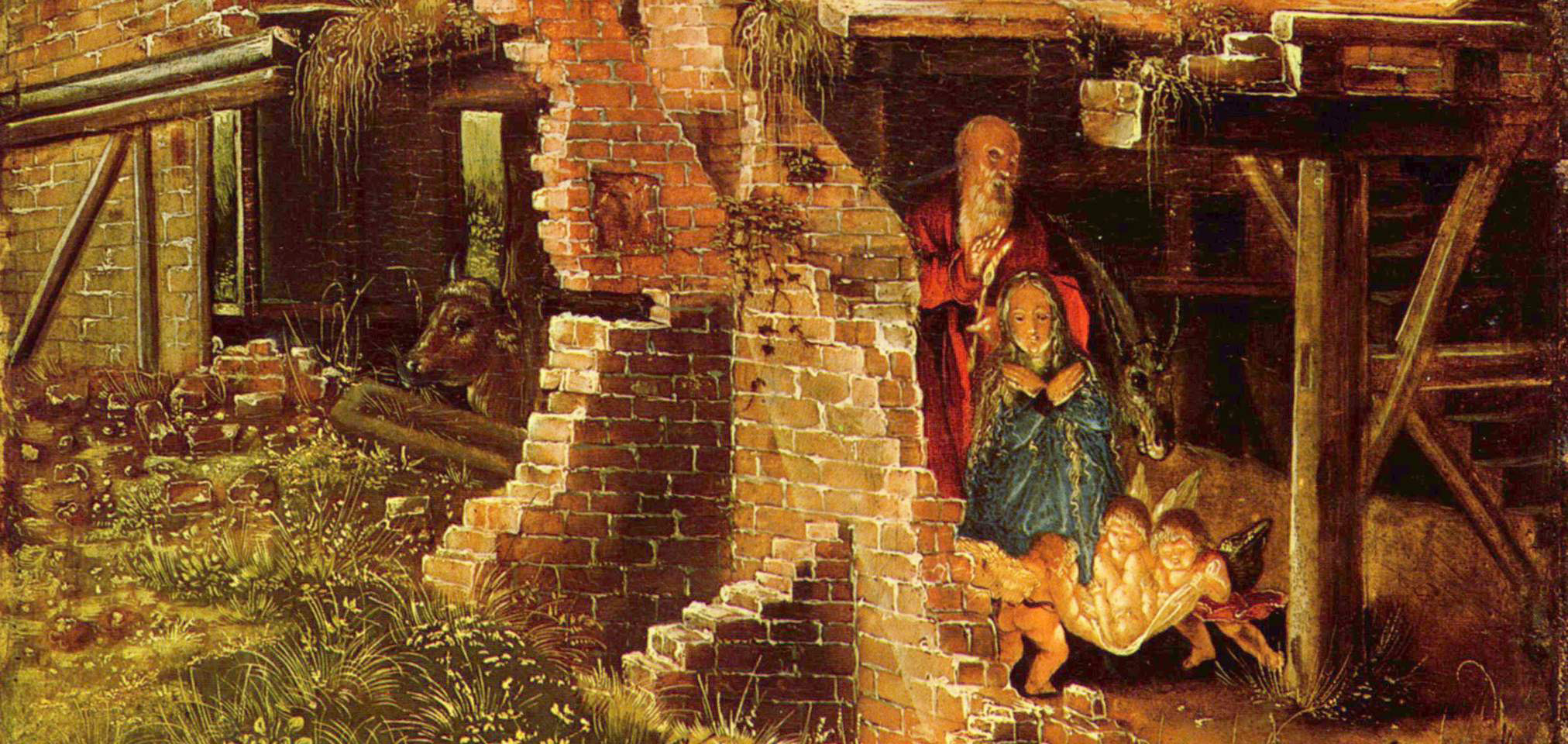
18 Dec Standing at the manger
The ox and the ass and a couple of shepherds from the fields celebrated the first Christmas. Above this manger, however, heaven was torn open. Angels and stars sang joyfully into the sacred night . . .
Each of us approaches Christmas with different personal feelings. . . . And despite all this, Christmas comes. . . . [W]e must hear again that Christ, the saviour, is born.
Dietrich Bonhoeffer, Sermon on Deuteronomy 32:48–52, Havana, Cuba, Fourth Sunday in Advent, 21 December, 1930.
I’ve wondered what feelings Christmas would bring this year. January started with quips about “seeing clearly in 2020.” Then came actual moments of apocalypse—of revealing—not just a pandemic, but a reckoning with realities that for many had been unseen—loneliness, inequality, violent oppression. Today I’m in the third week of Advent, waiting. It’s a time of weariness from carrying heavy burdens, sadness from losing loved ones, grief over violence that has been exposed.
I am invited to write on song and the Incarnation. In the context of the year that has been, I offer a voice that has encouraged me when it’s been difficult to sing, the voice of the young pastor Dietrich Bonhoeffer, who loved to celebrate Christmas in song. I pray his words will bless you in this Advent week.
I.
Berlin, 30 January, 1933. The night is pierced by flaming torches carried by twenty thousand Nazis marching through the city, celebrating Adolf Hitler’s so-called “seizure of power.” They are singing the anthem “Deutschland, Deutschland über Alles” (Germany, Germany above All). Hours later, Bonhoeffer speaks on radio to warn the nation against idolising human leaders. His broadcast is cut off. The new regime is starting to silence opposition.
The power of song to consolidate an inner vision of reality was well understood by the Nazis. In his somewhat autobiographical book Mein Kampf, Hitler sought to forge a national myth out of his failed coup attempt of 1923. 16 Nazis died in the coup. Hitler cast them as “martyrs,” a blood sacrifice for a people’s resurrection. This “salvific” event was re-enacted yearly through ritual. In November 1935, Hitler ordered that the martyrs’ bodies be marched from the Feldherrnhalle, where they had died, to a new pantheon of the “eternal guard.” The night before the march, he climbed the Feldherrnhalle steps and meditated silently before each coffin. The crowd looked on, torches alight. Then, a “Cantata for the 9th of November” was sung as a mystical commentary of the event. The role of song in Nazi ritual was on display.
Fuehrer, as you strode from this hallowed hall,
Night’s shadow fell from you
Because you carried the torch to the steps of death:
Lead us in our faith toward light,
Let the stones tremble under the power of your step . . .
Here, one historian writes, Hitler emerges transfigured, evoking “Christ who descended into hell and rose from the dead in order to bring salvation” (Vondung, 67). The song interpreted Germany’s reality. It told a story. Hitler overcame the nation’s death. He established an eternal Reich and offered “immortality” to those who sacrificed their lives to build it. His new humanity would live on in German blood and soil.
. . . The Reich’s flag billows over the grave.
Vondung’s account of this song captures what Bonhoeffer named idolatry. The song expressed a spirit of German absolutism. It conveyed an image of the “new human” as god (DBWE 11, 180). “Where death is final,” Bonhoeffer put it, “earthly life is all or nothing. Defiant striving for earthly eternities goes together with a careless playing with life . . . Nothing betrays the idolization of death more clearly than when an era claims to build for eternity, yet life in that era is worth nothing” (DBWE 6, 91).
The cantata was a lie—and the idolatry it voiced was deadly. The West, Bonhoeffer believed, was sliding into a nothingness that was “the utmost manifestation of all the forces opposed to God,” a nothingness that creates the illusion of waking all that exists to new life but “sucks out its true essence until it soon disintegrates into an empty husk and is discarded” (DBWE 6, 128).
What could keep the world from this void? Only a miracle: “the rescuing act of God that reaches in [and] creates new life out of nothingness—that is, the resurrection from the dead.” The Church’s task is the proclamation of this miracle, Jesus Christ, amid the “dissolution of all that exists” (DBWE 6, 131-2). This is the essence of Christian song. Christians sing a different story. The Church, Bonhoeffer writes, is the presence of Christ in the world, invisible as his eschatological body and visible as the church community (DBWE 1, 141). When the Church sings, the world hears the voice of Christ. It hears the truth, the Word of God, over against all other words and counterfeit worlds.
II.
In 1943, reflecting on ten years of resistance to Nazi influence in the church, Bonhoeffer likened the struggle to the “black cloud and bright lightning flash of a thunderstorm” (DBWE 6, 76-7). The demonic and the divine had been laid bare.
For the church, the night was deep. It was locked in a battle for what constitutes reality, against an enemy posing as an angel of light. At the heart of the battle was a conflict about death. Each side waged war in song. The Nazis sang the praise of the death of heroes. The church recognised death as a reality, and it sang its lament with Christ. It sang all the Psalms. Yet, finally, it sang of resurrection. “It is like a mocking song of triumph over death that Scripture sings,” Bonhoeffer says of 1 Corinthians 15.
O Death, where is your sting? . . . Death and sin puff themselves up . . . as if they were still the rulers of the world. But it is only an illusion. They have long since lost their power. Jesus has taken it from them. . . . When . . . the darkest hour comes over us, then [we] want to hear the voice of Jesus Christ calling in our ear: victory is won. (DBWE 15, 487)
Victory is won. Songs of joy fill Bonhoeffer’s reflections on death. The last funeral he led was for his friend, a Christian soldier, and the liturgy was mostly sung. These lines drew it to a close:
When darkness around me gathers,
Thy name and cross, still bright,
Deep in my heart are sparkling
Like stars in blackest night. . . .
For me to live is Jesus,
To die is gain for me;
Then, when-so-e’er He pleases,
I meet death willingly. (DBWE 16, 624)
Christ is the light who overwhelms the darkness. He is the resurrection and the life.
The Church sings the story of a dawn. We are a people of the morning, Bonhoeffer writes, of resurrection. Yet, it is still night in the world—and for Bonhoeffer, this is the heart of our song. The first light of dawn, in the Incarnation, is a sign. Now the Church waits in certain hope for the day when its joy will be complete. We sense this joy already as the nearness of our ascended King, “Master of joy beyond compare,” mingled with a sweet homesickness for the world of the resurrection (DBWE 12, 468-71).
The joy of the Church is Advent joy. Advent songs sing the reality of Christ in the night. “Christ will come, the prophet predicts; Christ has come, the church [proclaims]” (DBWE 14, 754). Mary’s Magnificat is a song of revolution. It is, Bonhoeffer writes,
the most passionate, the wildest . . . the most revolutionary Advent hymn that has ever been sung. This is not the gentle [Mary] portrayed in paintings. . . . There is none of the sweet, wistful . . . tone of many of our Christmas carols, but instead a hard, strong, relentless hymn about the toppling of thrones and the humiliation of the lords of this world. . . . Mary . . . speaks, by the power of [the] Spirit, about God’s coming into the world . . . (DBWE 13, 337-44)
At that time, a different story was being sung in Germany. Bonhoeffer heard a false song of victory, in the streets and in German churches (DBWE 12, 439-40). It was façade that hid the reality of a world sliding into an abyss. He heard another, more honest song emerging in the atonal music of Arnold Schoenberg and others. It was a fractured melody, the shrill sound of a world breaking apart (DBWE 11, 411).
Only the Church could sing truly into this night. It sang the song of Christ. In 1934, Bonhoeffer preached from Psalm 98:1.
O sing to the Lord a new song. The emphasis is on the word new. What is this new song, if it is not a song that makes someone a new person, when a person leaves darkness [and] breaks forth into new hope, new faith, new confidence? The new song . . . awakens God’s presence anew in us—even if it is a very old song, of the God who, as Job says, “gives songs in the night.” The song of praise in the night of our lives, of our suffering and our fear, in the night of our death—this is the new song. . . . Why should not we, here and now, look forward to that new song that will embrace us when we finally close our eyes, the purest, sweetest, hardest, and most violent of all songs. [Y]es, Lord . . . Let your song grow strong when ours fall silent, let the angels play when we drop our hands; when we lie on our deathbed, let your song resound . . . Lord, we hasten to join in your new song. Jesu juva—help us, Jesus. Amen. (DBWE 13, 357)
III.
Amen. Yes, Lord, I’ve sung your Advent songs over the years, but this year, in this week, it’s difficult to sing. Let your song grow strong when mine falls silent.
Nazi officials tore Bonhoeffer from his family in April 1943 and drove him to Tegel Prison. He had sent a Christmas letter to his friends the previous December, reminding them of the gift of the struggle against Hitler. Together, they had learned to view history from “the perspective of the suffering” (DBWE 8, 52).
This view deepened in prison. The first night was bitterly cold and, in an adjacent cell, a man was weeping. The next day Bonhoeffer was moved to solitary confinement. In a prison shaped like a cross, men were awaiting death (Bethge, 799). “The door slammed shut and locked,” he wrote later in a poem (DBWE 8, 418). As Christmas approached, he said his cell was “a good analogy for Advent; one waits, hopes . . . the door is locked and can only be opened from the outside” (DBWE 8, 188).
In the third week of Advent, Bonhoeffer wrote of a “sweet old man” who stood outside the prison every year on Christmas Eve and played carols on his trumpet. The effect was not what he intended. Instead of being comforted, the prisoners wailed and made noise in order not to weaken. In “the face of this misery that reigns in this building,” Bonhoeffer reflects, “a remembrance of Christmas that is . . . playfully sentimental is inappropriate” (DBWE 8, 232). Faithfulness to what is lost is to long honestly for it, not to cover it with sentimental substitutes, as one commentator puts it (Pangritz, 27).
Bonhoeffer wrote his last Christmas letter days later. He began with lines from Paul Gerhardt’s song, “I stand here at your manger,” which he had discovered in solitary confinement. “Every word is extraordinarily replete and radiant,” he had written, for alongside the “we” of the Church there is also an “I and Christ” (DBWE 8, 229-31).
I close with the same lines today. I am in the night. I am waiting for the dawn. I am silent.
Jesu juva. I long for your presence, Lord. I long to stand with the shepherds and see the light of your face. I long to know again that you are born.
This is my prayer for you this Advent week. Are you waiting? May you stand at the manger on Christmas night. May you see the face of Christ, our Sun, our dawning light. May the heavens above you be torn open and the angels and stars sing joyfully into the sacred night. May you join their song, and his song, even if your voice is quiet. And may you know that Christ is born.
I lay in deepest night of death,
You were my Sun,
The Sun that brought me
Light, life, delight, and joy.
O Sun, who prepared the precious light
Of faith in me,
How beautiful are your rays!
I behold you with joy
And cannot gaze enough on you;
And because I cannot do any more
I simply stand here, worshiping.
O that my mind were an abyss
And my soul a vast ocean
That I might be able to contain you!
Paul Gerhardt, “I stand here at your manger,” cited in Dietrich Bonhoeffer, Christmas Letter, 1943.
E. Bethge, Dietrich Bonhoeffer: A Biography, Revised Ed. (Minneapolis: Fortress Press, 2000).
D. Bonhoeffer (Dietrich Bonhoeffer Works, English Ed.):
DBWE 1: Sanctorum Communio: A Theological Study of the Sociology of the Church, ed. C. Green, trans. R. Krauss et al. (Minneapolis, MN: Fortress Press, 1998)
DBWE 6: Ethics, ed. C. Green, trans. R. Krauss et al. (Minneapolis, MN: Fortress Press, 2005).
DBWE 8: Letters and Papers from Prison, ed. J.W. de Gruchy, trans. I. Best et al. (Minneapolis, MN: Fortress Press, 2010).
DBWE 11: Ecumenical, Academic, and Pastoral Work: 1931-1932., ed. V.J. Barnett et al., trans. A. Schmidt-Lange et al. (Minneapolis, MN: Fortress Press, 2012).
DBWE 12: Berlin: 1932-1933, ed. L. Rasmussen, trans. I. Best et al. (Minneapolis, MN: Fortress Press, 2009).
DBWE 13: London: 1933-1935, ed. K. Clements, trans. I. Best et al. (Minneapolis, MN: Fortress Press, 2007).
DBWE 14: Theological Education at Finkenwalde: 1935-1937, ed. H.G. Barker et al., trans. D.W. Stott (Minneapolis, MN: Fortress Press, 2013).
DBWE 15: Theological Education Underground: 1937-1940, ed. V.J. Barnett et al., trans. V.J. Barnett et al. (Minneapolis, MN: Fortress Press, 2012).
DBWE 16: Conspiracy and Imprisonment: 1940-1945, ed. M.S. Brocker, trans. L.E. Dahill et al. (Minneapolis, MN: Fortress Press, 2006).
A. Pangritz, The Polyphony of Life: Bonhoeffer’s Theology of Music, trans. R. Steiner (Eugene, OR: Cascade Books, 2019).
K. Vondung, Paths to Salvation: The National Socialist Religion, Chapter 4, trans. W. Petropulos (South Bend, IA: St. Augustine’s Press, 2019).
(Image: “The Birth of Christ,” by Albrecht Altdorfer, CC Zero)

